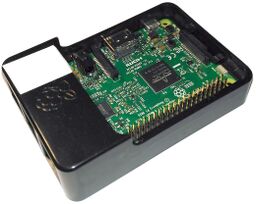NixOS on ARM/Raspberry Pi
| Raspberry Pi Family | |
|---|---|

| |
| Raspberry Pi | |
| Architecture | ARMv6 |
| Raspberry Pi 2 | |
| Architecture | ARMv7 |
| Raspberry Pi 3 | |
| Architecture | AArch64 + ARMv7 |
Status
Only the Raspberry Pi 3 is supported upstream, with the aarch64 effort.
Other Raspberry Pis are part of @dezgeg's porting efforts to ARMv6 and ARMv7.
Board-specific installation notes
First follow the generic installation steps to get the installer image and install using the installation and configuration steps.
Raspberry Pi (1)
The ARMv6 image boots out-of-the-box.
Raspberry Pi 2
The ARMv7 image should boot out-of-the-box, though the author hasn't personally tested this.
Raspberry Pi 3
Both the AArch64 and ARMv7 images boot out-of-the-box. Using the 64-bit AArch64 image is highly recommended, as the availability of binaries is much better and allows the use of the 64-bit instruction set.
Use the following GPIO Pins with an USB-TTL connector:
GND - 3rd in top row, black cable
GPIO 14 TXD - 4th in top row, white cable
GPIO 15 RXD - 5th in top row, green cableUse nix-shell -p screen --run "screen /dev/ttyUSB0 115200" to connect to the console.
{
...
hardware.enableRedistributableFirmware = true;
hardware.firmware = [
(pkgs.stdenv.mkDerivation {
name = "broadcom-rpi3-extra";
src = pkgs.fetchurl {
url = "https://raw.githubusercontent.com/RPi-Distro/firmware-nonfree/54bab3d/brcm80211/brcm/brcmfmac43430-sdio.txt";
sha256 = "19bmdd7w0xzybfassn7x4rb30l70vynnw3c80nlapna2k57xwbw7";
};
phases = [ "installPhase" ];
installPhase = ''
mkdir -p $out/lib/firmware/brcm
cp $src $out/lib/firmware/brcm/brcmfmac43430-sdio.txt
'';
})
];
networking.wireless.enable = true;
}
Serial console
Your configuration.nix will need to add console=ttyS0,115200n8 to the boot.kernelParams configuration to use the serial console.
{ config, pkgs, lib, ... }:
{
boot.kernelParams = [
"console=ttyS0,115200n8"
];
}
Binary Cache
Consider the channel http://hydra.earthtools.ca/jobset/arm/nixpkgs-arm-unstable/channel/latest as a binary cache.
Notes about the boot process
Raspberry Pi (all versions)
USB keyboards and HDMI displays work perfectly.
Using the 3.3v serial port via the pin headers (exact location depends on hardware version) will get u-boot output and, when configured, a Linux kernel console.
Troubleshooting
Power issues
Especially with the power-hungry Raspberry Pi 3, it is important to have a sufficient enough power supply or weirdness may happen. Weirdness may include:
- Lightning bolt on HDMI output "breaking" the display.
- Screen switching back to u-boot text
- Fixable temporarily when power is sufficient by swtiching VT (alt+F2 / alt+F1)
- Random hangs
The only solution is to get a properly rated USB power supply, AND a good cable. The cable has to be short enough to not incur power losses through the length. Do note that thin and cheap cables usually have thinner copper wires, which in turn accentuates power losses.
